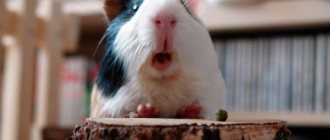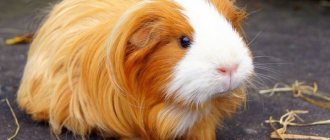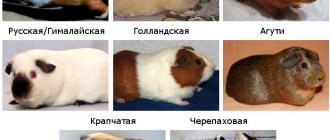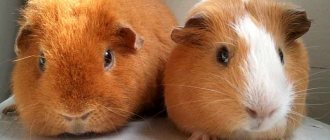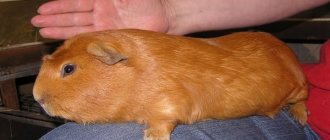Guinea pig and hamster are interesting and inquisitive animals. Both pets will definitely bring joy and fun to your home and will not let you get bored. The choice of a pet depends entirely on you: on your financial capabilities, on the available time for care, on the “requirements” for the pet, etc. Below you can get acquainted with the characteristics of each animal and the fundamental differences between them, which will help you make the right decision.
Guinea pigs are very friendly, while hamsters have an independent character
Who is better and who is worth buying
An analysis of the characteristics of animal care will help you make a choice - a guinea pig or a hamster. For example, a pet like a guinea pig is not very picky about careful care, like a dog or cat. If you take proper care of your pet, it can live up to 6 years. Pigs are active during the daytime, and at night they sleep, just like the owners of the house.
The owner of a guinea pig needs to periodically scratch its fur. They are very calm animals. They can play with children and are not aggressive at all. These pet rodents can be trained. Even schoolchildren can take care of pets.
When choosing a hamster or guinea pig, it is worth considering that hamsters are not recommended to be left to roam freely around the apartment. Because they can get into any hole.
You also need to know that the Syrian rodent can be very aggressive and two individuals cannot be housed in the same cage. In addition, hamsters of any breed become more active at night. You can buy a hamster for a child who has reached school age. This is not a suitable option for babies, as little friends can bite and are also quite fragile.
Who is better to have for a child?
Every child benefits from interacting with animals. He learns to look after his “younger brothers,” which develops in him the ability to take care of someone, to be careful, and to empathize. For a child over three years old, it is better to get a guinea pig. She is absolutely non-aggressive and friendly, she likes to be petted and communicated. But the hamster does not like unnecessary attention to itself. Insatiable children's interest often causes aggression in the animal, and it can bite.
It should be understood that both rodents are quite fragile animals, and a fall, even from a child’s height, can lead to bad consequences. Hamsters suffer most often when interacting with children. Small children do not yet have much control over their movements and can not only drop, but also squeeze a small rodent too much. Therefore, it is better to have them if the child is content with observing the funny behavior of this animal and does not often try to pick it up and squeeze it.
Did you know? A hamster's cheek pouches can hold an amount of food equal to a fifth of its weight.
If a child of any age loves to cuddle and pet animals, then it is better for him to get a guinea pig. When you suspect that your interest in animals will not last long, it is recommended to choose a hamster. But it should be taken into account that it is recommended to get this complex rodent no earlier than 6 years of age. The student will already understand how to handle a hamster.
Benefits of mumps
When considering the options - a hamster and a guinea pig, it is worth noting the pros and cons of such an acquisition.
Advantages of a sea rodent:
- Does not require complex care.
- Can get along with other pets.
- Trainable.
- Doesn't show aggression.
- Loves to be held.
- Larger than a hamster
- With good care it can live 6-10 years.
Pets are distinguished by their friendliness and calm character. They express goodwill with whistling sounds. They do not require special care.
Trained individuals are able to stand on their hind legs, roll a ball and follow the owner. Even a child can take care of an animal. It requires a spacious house where the animal can move a lot. You should place a wheel in the cage. The animal can be released for walks around the house, but it is necessary to monitor the pet so that it does not climb into hard-to-reach places.
Sawdust is great as bedding, as the animal loves to burrow in it. If you do not ensure regular cleaning, then over time the sawdust will begin to smell strongly.
There should be a drinking bowl with clean water in the cage. To allow your animal to grind its teeth, place a piece of wood or mineral stone in its home.
A simple diet is suitable for the diet. These can be grains, fruits, herbs and vegetables. Rodents especially love to feast on fresh cucumbers, apples and sweet peppers. They should not be fed with cheese, potatoes and meat.
It is worth considering that they do not take well to loneliness, so it is great if other rodents also live in the cage.
How to care for your pet to avoid unpleasant odor
Potential breeders of these furry animals, along with the question of whether guinea pigs stink, should also be interested in the question of how to properly care for their animals in order to avoid an unpleasant odor. So, the basic rules of care:
- Correctly selected cell size. A larger home will stay cleaner longer. The size of the cage should allow the animal to allocate a separate corner where it will relieve its needs.
Advantages of a hamster
Hamsters, unlike pigs, have a more finicky character. The Dzungarian or Syrian pet prefers to live alone in a cage.
Small animals should not be allowed to wander around the house, as they can get into small openings. If you touch a sleeping animal, then if it unexpectedly awakens, it can bite strongly.
Pets begin to be particularly active in the late afternoon. At the same time, they begin to rustle and rustle. The cage should be kept away from the sleeping area. It is better to locate the rodent’s home away from drafts, sunlight and heating equipment.
- Don't take up too much space.
- They do not require special attention.
- They are inexpensive.
- Easy to care for.
With good care, small rodents can live 3-5 years. It is better to get one for those who like to watch their pets from the outside. The animal likes to live separately. The cage can be of medium size, inside of which there is a house for sleeping. It is necessary to regularly clean the den, as the hamster loves to stock up on food.
In order for the animal to lead an active life, it is better to place a running wheel in the cage. A special filler or sawdust is suitable for bedding. It is worth paying attention to the composition of the diet, as there are foods that can harm your pet’s health.
What's good about a hamster
Hamsters are smaller in size and live less than guinea pigs. The Syrian hamster has a body length of up to 15 centimeters and a weight of 100-150 grams. Despite the fact that this is the largest species among domestic hamsters. Life expectancy is 2-3.5 years, depending on care.
These animals are loners. One cage - one pet. Even a male and a female cannot be housed together. To reproduce, the female is placed with the male only for the mating period. If you leave two animals together, there will be a fight with serious consequences.
The cage should measure 60 by 40 at a minimum. Moreover, it is the area that is important for them, and not the number of floors. These are very active nocturnal creatures that sleep during the day. The cage must have a running wheel. On it the animal will run several kilometers every day.
The Syrian hamster can be trained and accustomed to its name. This is not difficult to do. But you need to start from childhood, an adult is difficult to train and can even bite, of course, if it is not accustomed to handling. Most often, people choose to buy a Djungarian or Syrian hamster.
There are many types of hamsters, there are even 4-6 cm in size. They all have not only different sizes, weights, gluttony, but also characters. If one species is friendly, then you cannot approach another without gloves.
Results . It doesn't matter if it's a hamster or a guinea pig, they all need care. We are responsible for those we have tamed. Proper nutrition will prolong the life of both. Whoever you choose, before purchasing, study the character of the animal in order to avoid incidents and troubles. Now you know how they differ.
Choosing a pet
Both animals are similar in terms of care and nutrition. Differences are noticeable in abilities and character. The pig is easy to train, and hamsters do not like to be treated too closely.
With quality care, pigs live up to 6 years, and hamsters reach old age as early as one year. The hamster feels great alone, unlike the pig, for which this option is unacceptable.
Both animals are more common pets than the rodent degu, the common gerbil or the chinchilla. You can play with it or watch the antics of animals. If your baby likes to pet his pet, then a pig will do, but hamsters generally value freedom.
It doesn’t matter which pet the choice was made for. But for any animal it is necessary to provide high-quality and decent care.
Guinea pig and hamster are very interesting animals. They are characterized by increased activity and curiosity. These fluffies are real living sources of fun and joy for both adults and children. If an animal is purchased as a gift for a child, the age of the future owner should be taken into account. Guinea pigs are suitable for children from three years old, and hamsters are suitable for older children. But if age does not determine the choice, how to understand which of these rodents is better, and which pet to prefer?
Should I buy a guinea pig or a hamster for my child?
These pet rodents are living sources of fun and happiness for both adults and children. If you want to get a pet for a child, you need to take into account the age and character of the future owner.
It is better for children under three years old not to have pets at all, because this is not yet the most conscious age of a child, let the kids grow up a little.
Guinea pigs are perfect for children aged three years and older. These pets get along well with children and are friendly and playful. The absolute absence of aggression is also important to consider, because young children do not always know the limits and limits when playing with pets, to which a hamster, for example, can respond with a sharp bite. But older children can already choose a hamster as a pet. He will become a good friend for schoolchildren.
What you need to know about guinea pigs
These animals are easy to tame and fairly unpretentious in care and maintenance. The main thing is to feed and clean the cage on time. Among the advantages of these animals it is worth highlighting:
- simplicity and ease of maintenance and care;
- training opportunity;
- absolute absence of aggression;
- getting along with other pets;
- love of affection and tenderness;
- attachment to the owner.
If anyone in the family is allergic to wool, you can purchase a hairless skinny pig. The ability to have a pet even if you have allergies is another advantage of these rodents.
There are several factors to consider when purchasing a pig:
- The animals can be kept in same-sex pairs and will get along well;
- animals can be easily tamed;
- caring for them is not very difficult;
- with proper maintenance, life expectancy is 5 years, large breeds - up to 8 years;
- active during the day, they sleep at night.
The last point is very important when looking at the differences between a guinea pig and a hamster.
What breeds of guinea pigs are there?
In fact, there are enough breeds of guinea pigs to choose the pet that suits you best in character and appearance. The most common breeds include the following: American, Abyssinian, Peruvian, Sheltie, American Teddy, Texel, Crested, Rex, Coronet, Himalayan, Skinny. All breeds differ in coat length, color and behavioral characteristics. There are both long-haired breeds, such as the Coronet, Sheltie or Peruvian (the “furniest” breed), and short-haired ones, such as the Rex or Crested. There are guinea pigs that are very interesting in color, for example the Himalayan. Its color resembles Siamese cats. There are rodents with curly hair - texel. They look very impressive, which is why they are popular at exhibitions.
There are also completely exotic animals - this is the skinny breed. What sets it apart from others is that the animals of this breed have virtually no hair. It is present in small quantities only on the paws and face. Due to this peculiarity, some people are interested in how to maintain them, do they stink? The guinea pig (skinny breed) stinks a little less than other breeds. But this applies to the guinea pig's body odor itself. The skinny cage smells exactly the same as other breeds of cages.
What you need to know about hamsters
By nature, hamsters are picky. They don't recognize their neighbors. The normal life of a hamster is built according to the “one cage - one animal” scheme. If you put a rodent with a neighbor, a war will begin in the cage. The hamster will defend the territory and attack, there will be fights between neighbors, which, of course, will not end well.
Many people are interested in the question: are guinea pigs and hamsters friends or not? The answer is simple - hamsters are loners by nature. Therefore, by and large, they are not friends with anyone. Neither a guinea pig, nor a rat, nor other pets can be neighbors of a hamster. Not all hamsters show leniency and kindness even towards their own owner. And yet these fluffies have advantages:
- independence from communication with the owner;
- compact dimensions;
- ease of care;
- democratic price.
You should not let your hamster walk around the house - the little fluffy will begin to climb into all available holes, but it is far from certain that he will be able to get out of them.
Who smells more, the female or the male?
And yet, like any animal, guinea pigs are also not without their natural smell. Many people wonder: who is better to choose, a female or a male? Does a male guinea pig stink? Or does the female smell more?
Of course, differences by gender determine various physiological characteristics, including the emitted odor. Males, when excited, courting a female or marking, emit a pungent odor that does not depend on the cleanliness of the cell. Each person relates to this smell differently. Many owners note that it goes away quickly and is not that strong. However, for some it is still quite unpleasant.
The female may begin to smell after giving birth due to hormonal changes. However, this phenomenon is transitory and for owners who love their pet, this is not a disaster.
Making a choice
When choosing a pet, you should keep in mind that pigs live longer. The average lifespan of an animal is six years, provided that the owner takes good care of the pet. Hamsters barely reach three years of age. To prevent your child from getting upset so often, it is better to get a guinea pig. But still, you can’t focus only on lifespan. It is important to consider the pet's character and other factors.
Character and training
Guinea pigs are friendly, sociable, calm animals with a kind and easy-going character. They can easily live in the neighborhood with other pets - cats and dogs. Moreover, they are able to make friends with such neighbors and spend time with them together, without any conflicts or misunderstandings.
Pigs are very affectionate and loyal. They like to cuddle with their beloved owner - they are very willing to go into his arms and allow them to scratch their fur. When the owner comes into the pet's field of vision, it perks up and shows joy, making sounds similar to a whistle.
Aggression in character and behavior in pigs is completely absent. They never attack, even in self-defense; their method of defense is to hide away and quietly wait out the danger.
If the owner wants to train a pet, teaching the animal to perform various tricks is not difficult. The rodent is easy to train, a few trainings - and it will perform successfully, delighting both children and adults with its abilities. A pig can be taught:
- follow on the heels of the owner;
- rise on hind legs;
- roll the ball, pushing it forward with its face, etc.
If you compare who is smarter - a hamster or a guinea pig, the latter will win. Hamsters are intelligent, but stubborn. Assessing their mental abilities is problematic - they are almost impossible to train.
Hamsters of many breeds are characterized as aggressive fighters. However, if the owner takes certain precautions when interacting with the pet, he can avoid personal acquaintance with these qualities of the rodent. You shouldn’t disturb, much less touch, your fluffy when he’s sleeping. When frightened, a sleepy animal may bite.
Communication with a hamster is completely different from contact with a pig. The small rodent can hardly be called tame. He doesn't like hugs, the most he will allow is to stroke himself a few times. If a child does not count on a pet as a playmate and is not prone to prolonged squeezing of a fluffy animal, a hamster is ideal for a child. A pig with such an owner will become sad and melancholy.
With the right approach to a wayward pet, the owner may never discover the negative sides of his character and receive only positive things from the animal.
Lifestyle
The guinea pig's activity times coincide for the most part with the human daily routine. The animal conducts its main activity during the day. In the evening, his activity decreases and at night he sleeps peacefully, without disturbing his owner with his fuss.
The hamster differs from the guinea pig in that its activity period occurs at night. During the day, the pet sleeps and gains strength. And in the dark it is impossible to calm down the animal - it is during these hours that the peak of its activity and vigor comes. From the evening until the morning, the rodent fidgets, rustles, rustles, gnaws, runs, etc.
Therefore, if the owner wants to get some sleep, the cage with the hamster should be placed away from the sleeping area (or moved overnight). Otherwise, instead of sleeping at night, you will have to listen to the sounds of your pet’s vigorous activity.
Pigs are quite easy to care for. A 6-year-old child can carry out the necessary daily care independently. But it is difficult for children of preschool age (from three years old) to cope with such responsibilities, so until the child grows up, an adult needs to help him take care of the pet.
In addition, due to his age, it is difficult for the little owner to understand what is possible and what is not in handling the animal, so an adult will need to monitor the baby so that when playing with the pet, he does not go beyond what is permissible. Having suffered morally or physically, the animal may stop trusting its owner.
Hamsters, like pigs, do not require special care. Even children can take care of such a pet, but it is still better to give a rodent to a school-age child with a calm character. Such an owner will be able to simply observe the animal and will not force communication on it, which means there will be no conflicts.
Cell
A guinea pig needs space, so its cage should be of such a size that the animal can move around freely, but also run, play, etc. Physical activity is a prerequisite for a full life for a pet. If this is not done, the animal will become obese, its legs will become weak, which, of course, will negatively affect its general health.
The cage is placed in a quiet, warm room without drafts (otherwise there is a high risk that the animal will catch a cold). Your pet should not have access to wires, cables, etc. A domesticated rodent cannot resist its nature and will definitely try everything it comes across.
It is important to place a separate house in the pig’s cage, where the animal can retire - sleep, hide, etc.
The cage with the hamster is placed in a room with a calm environment, away from heating devices, direct sunlight and drafts. A medium-sized cage is suitable for a rodent. Inside, like a pig, there should be a house for privacy and relaxation. The hamster’s home (including the house) needs to be cleaned periodically - the thrifty animal will definitely stockpile food that will gradually spoil.
Nutrition
Pigs are undemanding when it comes to food. They love greens, grains and grains, vegetables and fruits. The best greens for animals:
As for the fruit and vegetable menu, it is better to include such fresh fruits as:
For pigs, the consumption of potatoes, meat and cheese is prohibited. The same cannot be said about hamsters. They can sometimes be treated to these products. The basis of a hamster’s diet should be:
Feed the little fluffy in the evening. The bowl is filled with food once a day. The daily diet should include grains and a tasty treat in the form of lettuce, carrot pieces or banana.
It is important to ensure that there are no prohibited foods on your pet’s menu.
Essential plaid accessories
The best bedding for pigs is simple sawdust. This little animal loves to bury itself in litter, so you should choose a safe material. The cage must be cleaned regularly - sawdust saturated with waste will smell bad.
The cage must be equipped with a drinking bowl and feeder. It is important to ensure that the animal always has access to:
- fresh clean water;
- feed;
- hay or fresh grass.
To grind down the claws and teeth, you need to provide the pig with a mineral stone or hard tree bark.
A pig's cage must have rides and sports equipment. The main requirement for this equipment is safety; the animal should not be injured. Every day the rodent needs to be released from the cage into the wild - for a walk, to run around the rooms of the house. But it’s important to monitor your pet’s movements—a curious explorer might climb where it shouldn’t or get stuck.
The hamster should also have sports equipment in its cage; a running wheel is recommended. To maintain health, a rodent must move a lot. The hamster's home should have a drinking bowl and a feeding trough. The water needs to be updated regularly, and the feeder should not be empty.
To grind down teeth and claws, the hamster needs to be provided with fresh branches of fruit trees (necessarily washed and dried).
The bedding should be made from a special filler or ordinary sawdust. But the latter will not protect against the spread of odor. Hamsters usually create a toilet area in their cage. Therefore, after cleaning, you need to put a couple of paper napkins in the cage - the animal will build a “bathroom” out of them. Your pet's toilet should be cleaned every three days, and the entire cage once a week.
If you cannot choose one over the other rodent, you can purchase both. The main thing to remember is that a guinea pig and a hamster cannot live in the same cage. A fighting little rodent will bite a large but kind pig. Do not create stress for both animals. It is best to create a separate home for each. Place the hamster alone, and the pig in the company of a relative (since they do not tolerate loneliness well), and everyone will be happy.
Care and maintenance of hamsters
Compared to the first rodent, the hamster is more finicky in its maintenance. He leads a solitary lifestyle and does not tolerate any neighbors, even if they are of the same breed as him. Among relatives living in the same cage, there is a constant struggle for territory. Therefore, you need to place each rodent, if you have several of them, in different cages, since the stronger individual will always offend the weaker one. Syrian hamsters are particularly aggressive. Throughout their lives, they may never get used to their owner and bite him at every opportunity. To avoid aggression, you need to be able to correctly pick up a hamster, not frighten it, and not touch a sleeping animal.
Like a guinea pig, a hamster requires a cage to live. The smaller the rodent, the larger its home should be. You can put wood filler or sawdust on the bottom. Do not use cotton wool, newspaper, or rough paper sheets as bedding. Khomka loves to hide, so a small house should be a mandatory attribute of his home. Rodents are very clean. It is not recommended to bathe them, because they take care of the cleanliness of their skin on their own. Cleaning the cage should be done once or twice a week. The hamster makes his own toilet. It should be cleaned as needed.
A naturally active animal constantly needs to release its energy somewhere. To do this, he needs to purchase various labyrinths and a running wheel. He should only walk around the house in a special ball, which can be bought at any pet store. You can’t let him go on his own journey, because he can easily get stuck somewhere or fall from a height. Hamsters have poor vision, but their hearing and sense of smell are well developed.
The food that suits him best is mixed feed, fruits, vegetables, nuts, grains, and herbs. It is imperative to include protein foods in his diet - chicken, milk, cheese, cottage cheese. There should always be clean water in the drinking bowl.
The most unpleasant thing about its content is that it shows its activity at night. Therefore, it is better not to leave the cage with the pet in the bedroom at this time, it will still not let the owner fall asleep. In general, the best location for an animal’s home is considered to be a place without drafts and with average illumination. Be careful, because hamsters are highly susceptible to colds. With proper care, hamsters can live for two to three years.
Which is better - a hamster or a guinea pig - for preschool children? There is no clear answer to this question. But when buying, remember that the hamster does not like excessive attention, he does not need affection and care. What suits him best is a calm home environment in which he will have the opportunity to live independently. But observing the life of a hamster is a very instructive and exciting activity. A hamster as a pet is more suitable for a schoolchild who will not impose his attention on him.
Keeping a Guinea Pig
One of the differences between this herbivore and a hamster is that it lives much longer, 5-6 years, with good care - up to 10. For many animal lovers this is very important. Becoming attached to a pet, the owners take its death very hard.
These are quite large animals: the body length can reach 25 cm, and the weight can range from 700 to 1000 g, with a maximum of 1.5-1.8 kg. Therefore, the cage must be spacious, at least 60x40 cm. Animals cannot be placed in aquariums, because there is no air circulation in them, fungus may appear, and the smell from feces will be strong.
It is better to use hay as bedding, but you can also use sawdust, granular or regular. Hay is an important part of the animal’s diet (up to 60%), a source of vitamins and other useful substances. In addition, the animal is fed grain and vegetables. If he does not receive enough hay and solid feed, this can lead to overgrown teeth, malocclusion, and, as a result, the inability to eat.
Rodents are diurnal. They are not very mobile. Occasionally, when hungry, they emit a loud whistle.
They get bored alone and need to communicate with members of their own species. Typically, rodents take food from each other's mouths, poke their faces, lick their ears, and exchange droppings. Communication with a person will not be a substitute. Therefore, it is better to have at least two animals at once. You need to choose a large cage so that there is enough space for both inhabitants.
When Can Guinea Pigs Really Smell?
If the unpleasant odor from your pet’s body is not its individual characteristic from birth and not the influence of certain factors (for example, the condition after pregnancy in females or the conditions described above in males), this is a reason to think about the state of your pet’s health. If your pig suddenly starts to smell unpleasant for no apparent reason, and even more so if this is accompanied by any other suspicious symptoms, this is a clear reason to contact a veterinarian. Do not neglect going to him, because in this case the health, and perhaps the life of your pet, depends on you.
Keeping a hamster
Let's figure out how a hamster differs from a guinea pig. Its lifespan is about two years. With proper care - 3-3.5 years. The rodent is small in size. The largest varieties reach 15 cm, dwarf varieties - 4-8 cm. Accordingly, they need less living space.
Hamsters, unlike pigs, are nocturnal. They are very mobile and need special devices to maintain motor activity, for example, a running wheel.
Owners may not like the night fuss and noise of a rotating wheel when their furry pet wants to go for a run. For normal life, he needs to cover 1-2 km a day.
Not all hamsters like to be held. It's better to explain this to your child. They bite much more often than marine ones, for which this is only a way to show that you have hurt them.
What you need to know about hamsters
Unlike pigs, hamsters are finicky creatures. B, otherwise the instincts of rodents, which tend to defend their territory, will lead to fights. It is undesirable to let hamsters out for walks around the house, since the rodent is able to crawl into even the smallest hole, from which it will be difficult to rescue it.
Character
They are distinguished by a degree of aggressiveness and pugnacity, which can manifest itself unexpectedly for the owner. If you touch a sleeping rodent, it may become frightened and, waking up urgently, bite its owner painfully. By following the basic rules of care and communication with the animal, unpleasant moments can be easily avoided, receiving only positive emotions from the hamster.
Lifestyle
The moment of activity in animals occurs at night; all day they rest quietly and sleep soundly. Towards evening, the hamsters begin to rustle, rustle and in every possible way remind of their existence. Sometimes they disturb their owners' sleep at night. For this reason, it is better to move the cage away from the sleeping area so that the animal cannot be heard.
Communication
Communication with a hamster will be of a specific nature: he does not like long sittings in your arms, preferring unobtrusive attention in the form of short strokes on the fur. If a child is not inclined to constantly communicate with an animal, it is better to get a hamster than a guinea pig.
Cell
The animal's cage should be located in a quiet place, avoiding the proximity of heating devices, open sun and drafts. can be medium in size with a special house. Like a guinea pig, a hamster needs shelter and a private place to sleep. By the way, the house needs to be cleaned regularly, since the hamster tends to stockpile food.
Necessary accessories in the cage
It is necessary to install a running wheel on the territory of the cage so that the animal has the opportunity to lead an active life. The water in the drinking bowl needs to be changed regularly, the feeders should be filled with grain food, periodically feeding the pet with fruit and vegetable desserts, and sometimes meat. A special kind of bedding or sawdust is suitable, but wood will not protect the house from the smell.
Hamsters tend to identify the bathroom in the cage, so after cleaning, you need to provide him with several paper napkins so that he can build one. If you decide to get a hamster, you will need to clean the sanitary area every 3 days, and carry out general cleaning once a week.
Nutrition
Since the rodent sleeps during the day, it needs to be fed in the evening. during the day, strictly observing that there are always grains in the feeder. Every day the animal should be treated to lettuce leaves, carrots or banana slices. requires attention, since there are products that will not benefit the health of the rodent. When in doubt, it is better to make sure that the treat is acceptable in order to avoid unpleasant consequences.
It is important that the cage contains fresh branches of fruit trees such as apple, pear or rowan so that the hamster can grind down its teeth and claws. Before offering cut branches to the rodent, they must be thoroughly washed and dried. When caring for a hamster, you should regularly inspect its possessions for supplies. Hidden food often spoils, exposing the animal to food poisoning.
Pros of a hamster
About the benefits of hamsters:
- do not require much attention;
- do not take up much space;
- ease of care;
- low cost.
A hamster will be good company for a calm schoolchild who will not impose his communication on the animal, content with observing the life of a funny rodent. Despite the hamster's isolation, you can always try teaching him to sit on his master's shoulder.
What is the difference between a hamster and a guinea pig?
Despite belonging to the same order and almost equally popular for home breeding, these animals have a number of fundamental differences:
- size is the first difference that immediately catches your eye. Compared even to the Syrian hamster (the largest breed of domestic hamster), the guinea pig looks much larger ;
- lifestyle is the most important difference, which often plays a decisive role when choosing a pet. The fact is that hamsters are nocturnal inhabitants, so you can only observe their active period of life in the late evening or at night, since small rodents sleep most of the day. Guinea pigs are more active during the day and rest at night . This is not to say that pigs sleep all night. Their sleeping style is very interesting - due to their increased fearfulness, pigs sleep for 10-15 minutes several times a day;
Nutrition - there is a difference both in the amount of food consumed and in the diet itself. A hamster needs much less food than a pig. You should feed him once a day, in the late afternoon, and regularly pamper him with cheese, lettuce leaves, meat or slices of bananas. Unlike hamsters, guinea pigs should not be given meat, cheese or potatoes. The pig should be given food 2 times a day - morning and evening. The main delicacy for pigs is fresh cucumber, sweet pepper and apple. A general rule for both rodents: there should be branches of fruit trees in the cage so that the pets can grind down their teeth
- life expectancy - rodents have a significant difference in this criterion. Guinea pigs live much longer: their average lifespan with proper care is 5-7 years. Hamsters rarely live past three years;
- learning ability - in this case, guinea pigs have an advantage. These animals are easy to train, so if desired, pigs can be trained to perform tricks of varying degrees of complexity. A trained pig can recognize its owner, follow him, roll a small ball with its muzzle, and also stand on its hind legs ;
- home - the difference is in the size of the cage, as well as its contents. A guinea pig needs a spacious cage in which it can lead an active lifestyle, since inactivity often leads to obesity. The cage should have a house or hammock in which the pig can sleep or hide. It is not necessary for a hamster to purchase a spacious cage; the main condition is the presence of various labyrinths and a running wheel in the cage. Like a guinea pig, a hamster needs a place to sleep and hide. It is important that the hamster’s house needs to be cleaned regularly, because this thrifty animal tends to carry and hide food that can quickly spoil;
- walk: you should not let your hamster out for a walk around the house - he will definitely be attracted to some hard-to-reach place that will vaguely remind him of a hole. Getting the baby out of there will be a real challenge, so you need to let the hamster go for a walk only in a special ball, which can be purchased at a pet store. With a guinea pig, things are much simpler - you can and even need to let him go for a walk . Catching it will not be difficult due to its large size and slowness.
Children under 3 years old should not have a pet at all.
Hamster and pig living together
Pigs cannot live with hamsters
If you appreciate the merits of both types of animals and decide to have both. To save space, you should not place them in the same cage for several reasons:
- The cage for a guinea pig should be large enough, the dimensions of the base should be 60x40cm. Typically, such cells have sparsely located rods. A small hamster can easily leave its boundaries.
- In nature, hamsters live alone and react aggressively to anyone who violates the boundaries of their territory. A larger neighbor, despite her size, may become the target of an attack. Then you won’t be able to do without bites and wounds.
- Size differences: A large pig can crush a hamster, especially a dwarf breed.
- Rodents have different eating preferences. Living in the same cage, they can feed on each other's supplies, which can affect their health.
Interestingly, guinea pigs are calm towards strangers of other species. They either don’t notice them, or use them to warm themselves and enjoy food. They fight mainly with their relatives for the house. But her living with a hamster is unacceptable.
Is it possible to keep a hamster and guinea pig together?
Hamsters do not tolerate other claimants for territory near them. They cannot be kept together in the same cage, even with individuals of their own species. At the sight of a competitor, any hamster begins to get nervous and behave aggressively. This small rodent can bite a guinea pig, although it always behaves calmly and peacefully. Even if there is no conflict, when living together they can eat each other’s food, and the recommended diet for these animals is somewhat different.
In addition, when moving around the same territory, a larger guinea pig can accidentally injure or crush a small hamster. For the latter, this could end badly. If you decide to get both a hamster and a guinea pig, then each of them should have a separate cage.
Hamsters and guinea pigs are small pets that are often adopted at the request of a child. They require a cage with accessories, food and proper maintenance. Guinea pigs require constant communication and are tame, non-aggressive animals. Small hamsters are individualists who don’t like to be disturbed too much; it’s good to watch them, but you shouldn’t pick them up often.
Source
Pros and cons
Let's summarize, highlight the advantages and disadvantages.
Pros of a guinea pig:
- Unpretentious in content;
- Very friendly and affectionate;
- Trainable;
- A naturally intelligent animal;
- Contact with other pets.
If you buy a rodent for a child to play with, then you won’t find a better pet, because pigs love to be given a lot of attention, love to be held, and never show aggression. For a child with allergies, you can choose a skinny pig; these are hairless, terribly funny and cute rodents. The negative points are that pigs have a stronger smell than hamsters, so they will need to clean their home and change the litter more often, but they do not require as much variety in food as the other pet.
Pros of a hamster:
- Do not require special care;
- Clean and independent;
- Almost omnivorous;
- They take up little space.
Among the minuses, we can note the fact that this is a gloomy animal, does not sleep at night and leads an active lifestyle. So, a hamster can run in a wheel all night, rummage through litter, tear napkins, and run through a maze. In a small apartment, the noisy sounds it makes will be heard. The animal leads a solitary lifestyle, does not tolerate being given excessive attention, and can bite and scratch. Hamsters are well suited for a child over six years old, since at this age the basic requirements for caring for a pet can already be explained to him.
After familiarizing yourself with the peculiarities of keeping pet rodents, you will be able to make the right decision on which one is best to purchase. In any case, both animals are cute, interesting animals that can brighten up your leisure time.
Before buying a pet, every person tries to find out as much information as possible about it. This is important to have an idea of the positive and negative aspects of being with an animal.
Everyone knows that a guinea pig is a pet, but perhaps only a few know what it’s like to live with a rodent in the same house.
These cute animals have negative character traits, but not many of them:
- Complex nature.
Guinea pigs rarely show their temper. This can happen due to the fact that the previous owner treated her poorly, offending and causing pain. After this, the animal becomes timid, withdrawn and does not make contact with humans. - They damage property.
The guinea pig is, of course, a pet, but still a rodent. You should not let the animal roam around the apartment without the supervision of the owner. After such walks, you will end up with damaged wallpaper, furniture and wires. Nature will still prevail over the pet. - Clean your fur coat. This “flaw” only applies to pigs with long hair. The animal is not able to cope with its hair on its own, so it requires human help.
Does a guinea pig stink? Owner reviews
Of course, before bringing a guinea pig into your home, responsible people will first thoroughly study all the information about these animals, including reviews from the owners.
So, does a guinea pig stink? Reviews from the owners do not hide the shortcomings of these cute animals, namely their specific smell. The phenomenon does occur, but most of all it is connected, as has been said repeatedly, with a violation of their hygiene. A certain percentage of owners claim that their pets have an odor, even despite careful hygiene. There are those who say that their pet does not emit an unpleasant odor, and if you regularly clean the cage, there will be no problems with this. Thus, the main percentage of guinea pig owners believe that if you rarely clean the rodent’s home, the “aroma” will undoubtedly be present, and if you clean everything on time, then only a small percentage of these animals will have an unpleasant odor, which is most likely due to their individual characteristics or health problems.
Advantages and disadvantages of content
So, both hamsters and guinea pigs live in similar conditions. The choice between them may be influenced by the following features:
- life expectancy (guinea pigs live much longer than hamsters);
- cage size (much smaller for a hamster);
- special feeding requirements (hay is a mandatory element when breeding guinea pigs);
- lifestyle (day or night, solitary or collective).
Each of the conditions can be a plus or a minus, depending on the lifestyle and needs of the owners. The decision of who is more suitable for you, a hamster or a guinea pig, is made individually.
Ideal pet rodent: guinea pig or hamster?
Guinea pig and hamster are interesting and inquisitive animals. Both pets will definitely bring joy and fun to your home and will not let you get bored. The choice of a pet depends entirely on you: on your financial capabilities, on the available time for care, on the “requirements” for the pet, etc. Below you can get acquainted with the characteristics of each animal and the fundamental differences between them, which will help you make the right decision.
Guinea pigs are very friendly, while hamsters have an independent character
Recommendations
Pets are most often purchased at the request of children. A child needs communication with living nature. Psychologists and teachers believe that caring for a pet, empathy, and the emotions that a child receives when interacting with it help develop the best human qualities. An animal at home becomes an incentive to understand the world around us. Responsibility and respect for nature are fostered.
Regardless of who you choose, parents must follow a few rules:
- explain that a hamster or guinea pig is not a toy for a child, but a living creature that has its own needs, its own character;
- talk about the characteristics of pets, lifestyle, care rules so that the child understands what can be done and what cannot be done, and why;
- to be aware that, no matter how old the child is, the responsibility for the purchase lies with the adult: he must monitor compliance with the rules of care and the health of the animal.
Communication with a pet, be it an active hamster or a calm guinea pig, should bring positive emotions to both the child and the adult. And joint care brings parents and children closer together.
Choosing a pet
Both animals are similar in terms of care and nutrition. Differences are noticeable in abilities and character. The pig is easy to train, and hamsters do not like to be treated too closely.
With quality care, pigs live up to 6 years, and hamsters reach old age as early as one year. The hamster feels great alone, unlike the pig, for which this option is unacceptable.
Both animals are more common pets than the rodent degu, the common gerbil or the chinchilla. You can play with it or watch the antics of animals. If your baby likes to pet his pet, then a pig will do, but hamsters generally value freedom.
It doesn’t matter which pet the choice was made for. But for any animal it is necessary to provide high-quality and decent care.
